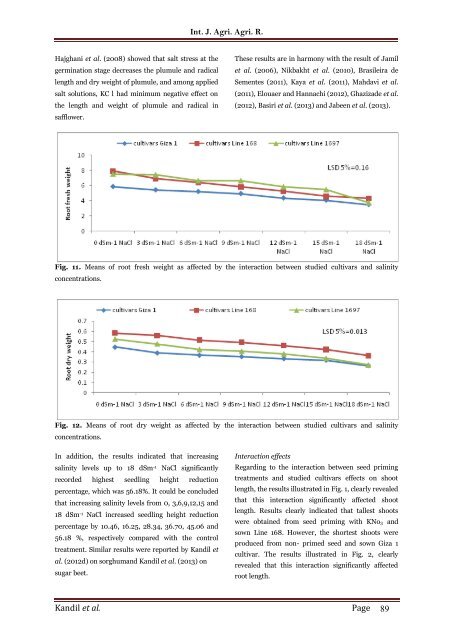Seedling parameters as affected by seed priming of some safflower cultivars under salinity stress
A laboratory experiment was conducted at Giza Central Seed Testing Laboratory of Central Administration for Seed Certification (CASC), Ministry of Agriculture, Egypt. Seedling parameters i.e. shoot and root length, shoot and root fresh weights, shoot and root fresh dry weights; seedling height reduction and relative dry weight were estimated. Highest averages of the shoot and root lengths, shoot and root fresh weights, shoot and root dry weights, seedling height reduction and relative dry weight were produced from seed priming in NaCl or KNo3. Line 168 cultivar surpassed other studied cultivars in of shoot and root length, shoots and root fresh weights, shoots and root fresh dry weights, seedling height reduction and relative dry weigh. Increasing salinity levels from 0 to 3, 6, 9, 12, 15 and 18 DSM-1 NaCl significantly decreased all studied characters except seedling height reduction percentage which was an increase. Shoot length, shoot and root fresh weights, root dry weights, seedling height reduction and relative dry weight significantly affected by the interaction between seed priming treatments and cultivars. Shoot length, shoot and root fresh weights, shoot and root fresh dry weights, seedling height reduction and relative dry weight significantly affected by the interaction between cultivars and salinity concentrations, by the interaction among seed priming, cultivars, and salinity concentrations. It could be concluded that seed priming in NaCl or KNo3 of Line168 or Line 1697 cultivars were more tolerant to salinity stress, which must be put in the breeding program of safflower for enhancing of safflower productivity under salinity conditions.
A laboratory experiment was conducted at Giza Central Seed Testing Laboratory of Central Administration for Seed Certification (CASC), Ministry of Agriculture, Egypt. Seedling parameters i.e. shoot and root length, shoot and root fresh weights, shoot and root fresh dry weights; seedling height reduction and relative dry weight were estimated. Highest averages of the shoot and root lengths, shoot and root fresh weights, shoot and root dry weights, seedling height reduction and relative dry weight were produced from seed priming in NaCl or KNo3. Line 168 cultivar surpassed other studied cultivars in of shoot and root length, shoots and root fresh weights, shoots and root fresh dry weights, seedling height reduction and relative dry weigh. Increasing salinity levels from 0 to 3, 6, 9, 12, 15 and 18 DSM-1 NaCl significantly decreased all studied characters except seedling height reduction percentage which was an increase. Shoot length, shoot and root fresh weights, root dry weights, seedling height reduction and relative dry weight significantly affected by the interaction between seed priming treatments and cultivars. Shoot length, shoot and root fresh weights, shoot and root fresh dry weights, seedling height reduction and relative dry weight significantly affected by the interaction between cultivars and salinity concentrations, by the interaction among seed priming, cultivars, and salinity concentrations. It could be concluded that seed priming in NaCl or KNo3 of Line168 or Line 1697 cultivars were more tolerant to salinity stress, which must be put in the breeding program of safflower for enhancing of safflower productivity under salinity conditions.
You also want an ePaper? Increase the reach of your titles
YUMPU automatically turns print PDFs into web optimized ePapers that Google loves.
Int. J. Agri. Agri. R.<br />
Hajghani et al. (2008) showed that salt <strong>stress</strong> at the<br />
germination stage decre<strong>as</strong>es the plumule and radical<br />
length and dry weight <strong>of</strong> plumule, and among applied<br />
salt solutions, KC l had minimum negative effect on<br />
the length and weight <strong>of</strong> plumule and radical in<br />
<strong>safflower</strong>.<br />
These results are in harmony with the result <strong>of</strong> Jamil<br />
et al. (2006), Nikbakht et al. (2010), Br<strong>as</strong>ileira de<br />
Sementes (2011), Kaya et al. (2011), Mahdavi et al.<br />
(2011), Elouaer and Hannachi (2012), Ghazizade et al.<br />
(2012), B<strong>as</strong>iri et al. (2013) and Jabeen et al. (2013).<br />
Fig. 11. Means <strong>of</strong> root fresh weight <strong>as</strong> <strong>affected</strong> <strong>by</strong> the interaction between studied <strong>cultivars</strong> and <strong>salinity</strong><br />
concentrations.<br />
Fig. 12. Means <strong>of</strong> root dry weight <strong>as</strong> <strong>affected</strong> <strong>by</strong> the interaction between studied <strong>cultivars</strong> and <strong>salinity</strong><br />
concentrations.<br />
In addition, the results indicated that incre<strong>as</strong>ing<br />
<strong>salinity</strong> levels up to 18 dSm -1 NaCl significantly<br />
recorded highest <strong>seed</strong>ling height reduction<br />
percentage, which w<strong>as</strong> 56.18%. It could be concluded<br />
that incre<strong>as</strong>ing <strong>salinity</strong> levels from 0, 3,6,9,12,15 and<br />
18 dSm -1 NaCl incre<strong>as</strong>ed <strong>seed</strong>ling height reduction<br />
percentage <strong>by</strong> 10.46, 16.25, 28.34, 36.70, 45.06 and<br />
56.18 %, respectively compared with the control<br />
treatment. Similar results were reported <strong>by</strong> Kandil et<br />
al. (2012d) on sorghumand Kandil et al. (2013) on<br />
sugar beet.<br />
Interaction effects<br />
Regarding to the interaction between <strong>seed</strong> <strong>priming</strong><br />
treatments and studied <strong>cultivars</strong> effects on shoot<br />
length, the results illustrated in Fig. 1, clearly revealed<br />
that this interaction significantly <strong>affected</strong> shoot<br />
length. Results clearly indicated that tallest shoots<br />
were obtained from <strong>seed</strong> <strong>priming</strong> with KNo3 and<br />
sown Line 168. However, the shortest shoots were<br />
produced from non- primed <strong>seed</strong> and sown Giza 1<br />
cultivar. The results illustrated in Fig. 2, clearly<br />
revealed that this interaction significantly <strong>affected</strong><br />
root length.<br />
Kandil et al. Page 89


















